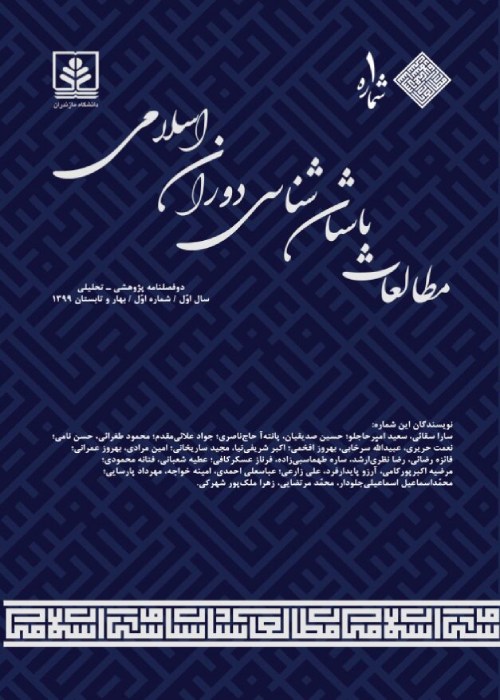The Study of the Luster tiles Star Shaped in Ilkhanid Era the based on Bonyads Collection Museum
Like many artifacts and fine art, not only tiles reflect the practical needs of the artist, but also they represent lifestyle, landscape, beliefs and worldview of a society. Regardless of its insulating effectiveness, tiles have turned into a good visual source to record human history. Following a time-consuming process, tiles evolved from the most primary forms, which were the glazed tiles, into a unique aspect of the early and middle Islamic art. The most developed form of this art-industry are luster tiles. Due to mass production of metal dishes and artifacts in the historic era, the artists of the pottery industry were forced into poverty. With the rise of pottery dishes, artifacts and luster tiles in the Islamic era, the missing elements returned into attention; in such a way that the crafting techniques of lusterware and its production was a nationwide privilege and rarely been exclusive. In most of the museums in the world, sections are dedicated to these types of artworks which indicates its importance, and also became the source of motivation for architectural historians, art historians and archaeologists in order to specifically study these artworks and achieve valuable results in stylistics and interpretation of miniature paintings and inscriptions.
In a section in Ramsar’s Shohada cultural complex which is affiliated with the Mostazafan Foundation, there are many tiles from the Islamic era which many of them are lusterwares and have never been studied and also their stylistics and structural features are unidentified. The purpose of this article is to study, interpret and introduce five samples of lusterwares by using historical evidence, field and documentary studies. The following article studies these five samples based on two fundamental questions; one argues the decorations and the other argues the time and place of production. Four of the tiles are classified in star shaped pattern category while two of them are classified in clayey; all of them are made out of stone paste. Due to multiple sides, especially in curved shapes mixed with other tiles decorated with cross patterns, the stellar pattern consists more joints.
This particular feature reduced the weight effectivity which was a challenging point; As a result, it created more surface for the paste and helped stabilizing the vertical frames which were even more challenging. The main combination of colors of samples are brown, copper, copper-red and cream. The length and width of the samples which are decorated with star shaped pattern is 21 cm and they are 2 cm thick. Most of the edges are covered with an azure tape while the tape in some other samples is colored in cream. All the star shaped patterned tiles are decorated with either brown or copper inscriptions written in Naskh; the inscriptions are written on a white tape on the outer part of the edge. Two of the inscriptions are either covered with an azure tape or sprayed paint which makes it difficult to translate. Inscriptions contain orders, exhortation, moral advice and mythical themes. Only one sample is labeled with month and the year of production. In atar shaped patterns, the decorations are centered in the inner star. All of the samples are themed in flowers, plants and petal motifs. Only one sample contains a human motif; the motif is illustrated in Islamic medieval style also known as the Mongole style which is identified with a round face, stretched eyes and curved eyebrows with long eye lines. The outfits are decorated with stamped and paisley motifs. The head of the individuals are highlighted in an azure circle. In this sample, four of the human motifs are portrayed from the front and one is portrayed from the side. The outfit, hairstyle and the facial features of the one portrayed from the side is different from the others and also the motif pictures a man. The hand expression of this individual is indicating that he is having a conversation with the woman in front of him. This series of pictures are portraying a romantic scene.
In most of the samples, a romantic scene of either a male and a female bird or a couple of gazelles are portrayed. This is the same style as the luster tiles from the middle Islamic era and the later in blue and white tiles. The artist portrayed his intention by coloring the motifs and main decorations in azure. In some of the samples the eternal love of flowers, lovebirds, warblers and nightingales which are the main themes of the Iranian poetry and miniature paintings is noticeable. The theme of the portrayed landscapes are Golestan/Boustan/Persian gardens which contains elements such as flowers, water or fishes and songbirds in one frame. Other landscapes portray a scene of an Iranian Paradis (graden) with animals such as deer and giant birds like cranes. Although there are limitations in terms of portraying motifs, the artist has successfully portrayed the dynamism of the scene by illustrating the surface of the water waves, dancing cranes with twisted necks and the wandering gazelles. The most important issue about these samples is the lack of harmony between the inscriptions and the motifs; one exhorts and the other sings a saga while the motifs are mainly portraying romantic scenes in Golestan/Persian gardens. According to the craftsmanship, school of motifs and the poems they carry, all samples date back to 7th and 8th centuries A.H. Due to the compressed motifs and the coloring style, most of the tiles might have manufactured in Kashan and some of them might have manufactured in Sultaniyeh. The clay samples which are part of an architectural element (possibly an altar), are constructed in a very high level of quality. An inscription written in Thuluth contains texts from Surah al-Sharh in Quran which indicates that two samples belong to the same building, same location and the same inscription. Their craftsmanship style is comparable to the manufactured samples in Kashan and they date back to late 8th to early 10th centuries A.H.
- حق عضویت دریافتی صرف حمایت از نشریات عضو و نگهداری، تکمیل و توسعه مگیران میشود.
- پرداخت حق اشتراک و دانلود مقالات اجازه بازنشر آن در سایر رسانههای چاپی و دیجیتال را به کاربر نمیدهد.



